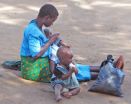Researchers see more West Nile virus in orchards and vineyards
Detailed ecological look could lead to better disease management
2013-01-31
(Press-News.org) PULLMAN, Wash.—Washington State University researchers have linked orchards and vineyards with a greater prevalence of West Nile virus in mosquitoes and the insects' ability to spread the virus to birds, horses and people.
The finding, reported in the latest issue of the journal PLOS ONE, is the most finely scaled look at the interplay between land use and with the virus's activity in key hosts. By giving a more detailed description of how the disease moves across the landscape, it opens the door to management efforts that might bring the disease under control, says David Crowder, a WSU entomologist and the paper's lead author.
Since it was first seen in New York in 1999, West Nile virus has reached across the country and shown few signs of abating. Last year, the Centers for Disease Control had the highest number of reported cases—5,387, including 243 deaths—since 2003.
Roughly one in five infected people experience a fever, headache, body aches and, in some cases, a skin rash and swollen lymph glands. One in 150 people can get a high fever, headache, neck stiffness, disorientation and neurological problems.
Most efforts to suss out the ecological workings of the virus have focused on reports of infected people, "a crude indicator at best," says Crowder. Almost all victims have no symptoms or are misdiagnosed, while others can be infected far from where they file a report, he says.
Agricultural areas have also seen higher percentages of infected people, but that still does not get at the underlying mechanism.
"Is that because there are more birds there?" says Crowder. "Is that because there are more mosquitoes there? That hasn't really been linked together."
Crowder, working with fellow entomologist Jeb Owen, other WSU colleagues and the state Department of Health, merged data from a variety of sources, including West Nile infections in humans, horses and birds, surveys of virus-bearing mosquitoes, breeding bird surveys, and detailed land use maps and climate data from around the Northwest.
The researchers found that habitats with high instances of the disease in horses and birds also have significantly more mosquitoes, as well as American robins and house sparrows, the two bird species implicated the most in the disease's transmission.
"These same habitats are also resulting in much higher rates of infection within mosquitoes themselves," said Crowder.
"We find that all three of these things—abundances of house sparrows and American robins, abundance of mosquitoes, and the actual prevalence of West Nile in mosquitoes—are all increasing in landscapes with a higher proportion of land in orchard habitats." These habitats, says Crowder, include both orchards and vineyards.
It's still unclear why the habitats would create such a perfect storm for the virus. The researchers speculate that mosquitoes are drawn to orchards for plant nectar during flowering, while robins and house sparrows use them for nesting and feeding. Together, the insects and birds become focal points for the disease.
### END
ELSE PRESS RELEASES FROM THIS DATE:
BRI researchers identify biomarker and potential therapy target in multiple sclerosis
2013-01-31
(Seattle, January 30, 2013) Researchers from Benaroya Research Institute at Virginia Mason (BRI) have found that proteins in the IL-6 signaling pathway may be leveraged as novel biomarkers of multiple sclerosis (MS) to gauge disease activity and as a target for new therapies. The research, which investigated how several components involved in immune response differ between MS patient and control samples, was conducted by a team of researchers at BRI led by Dr. Jane Buckner in collaboration with Dr. Mariko Kita at Virginia Mason Medical Center and was published today in ...
3D microchip created
2013-01-31
Scientists from the University of Cambridge have created, for the first time, a new type of microchip which allows information to travel in three dimensions. Currently, microchips can only pass digital information in a very limited way - from either left to right or front to back. The research was published today, 31 January, in Nature.
Dr Reinoud Lavrijsen, an author on the paper from the University of Cambridge, said: "Today's chips are like bungalows – everything happens on the same floor. We've created the stairways allowing information to pass between floors."
Researchers ...
Disasters can prompt older children to be more giving, younger children to be more selfish
2013-01-31
A natural disaster can bring out the best in older children, prompting 9-year-olds to be more willing to share, while 6-year-olds become more selfish. Researchers at the University of Toronto, the University of Chicago, and Liaoning Normal University made this finding in a rare natural experiment in China around the time of a horrific earthquake.
A crucial difference between the two age groups emerged one month after the disaster. The 6-year-olds' willingness to share in a test measuring altruism dropped by a third, while among 9-year-olds, willingness to give to others ...
Doubt cast on Sir Bernard Lovell's brainwashing
2013-01-31
In this month's edition of Physics World, science writer Richard Corfield casts doubt on the alleged "brainwashing" of the late British astronomer Sir Bernard Lovell by the Soviets at the height of the Cold War and explains how his trips beyond the Iron Curtain laid the foundations for the easing of geopolitical tensions between the UK and the USSR.
Speaking to Lovell's son Bryan, Corfield reveals a more mundane explanation for why Lovell, who founded the Jodrell Bank telescope in the UK, fell ill on his return from the USSR in 1963.
"For me the more likely explanation ...
Gut microbes at root of severe malnutrition in kids
2013-01-31
A study of young twins in Malawi, in sub-Saharan Africa, finds that bacteria living in the intestine are an underlying cause of a form of severe acute childhood malnutrition.
The research, led by Washington University School of Medicine in St. Louis and reported Feb. 1 in the journal Science, shows how dysfunctional communities of gut microbes conspire with a poor diet to trigger malnutrition.
The discovery is bolstered by additional studies in mice, showing that gut microbes transplanted from malnourished children cause dramatic weight loss and alter metabolism when ...
Biofuels blend right in
2013-01-31
Winemakers have long known that blending different grape varietals can favorably balance the flavor characteristics of the wine they produce. In the future, makers of advanced biofuels might use a similar strategy, blending different feedstock varieties to balance the energy characteristics of the transportation fuel they produce.
A collaborative study by researchers with the U.S. Department of Energy (DOE)'s Joint BioEnergy Institute (JBEI), a bioenergy research center led by Berkeley Lab, and the Idaho National Laboratory (INL) has shown that an ionic liquid proven ...
In beef production, cow-calf phase contributes most greenhouse gases
2013-01-31
Jan. 30 2013 - Scientists have long known that cattle produce carbon dioxide and methane throughout their lives, but a new study pinpoints the cow-calf stage as a major contributor of greenhouse gases during beef production.
In a new paper for the Journal of Animal Science, scientists estimate greenhouse gas emissions from beef cattle during different stages of life. They show that, depending on which production system farmers used, beef production has a carbon footprint ranging from 10.7 to 22.6 kg of carbon dioxide equivalent per kg of hot carcass weight.
According ...
Confirmed: How plant communities endure stress
2013-01-31
PROVIDENCE, R.I. [Brown University] — Ecology is rife with predation, competition, and other dramatic "negative interactions," but those alone do not determine the course life on Earth. Organisms sometimes benefit each other, too, and according to the Stress Gradient Hypothesis, their "positive interactions" become measurably more influential when ecosystems become threatened by conditions such as drought. Ecologists have argued about the hypothesis ever since Brown University ecologist Mark Bertness co-proposed it in 1994; Bertness says a large new global meta-analysis ...
Peer pressure trumps 'thin' ideals in the media
2013-01-31
Peers exert a greater influence on teenage girls' dissatisfaction with their bodies than do thin ideals in television or social media use, according to new research¹ by Dr. Christopher J. Ferguson and colleagues from Texas A&M International University in the U.S. Their study is published online in Springer's Journal of Youth and Adolescence.
The influence of the media on body image, life satisfaction, and symptoms of eating disorders in teenage girls is a hot debate. Some experts believe that media influences on body dissatisfaction may extend to symptoms of eating disorders. ...
Lake Mead aquatic-science research documents substantial improvements in ecosystem
2013-01-31
LAS VEGAS, Nev. — Lake Mead National Recreation Area's water quality is good, the sport fish populations are sufficient, and the lakes provide important habitat for an increasing number of birds. This positive trend is documented in a new report published today that leads to a better understanding of the natural resources of Lake Mead and Lake Mohave, and the issues that may affect natural resource management of Lake Mead NRA.
"While the Lake Mead ecosystem is generally healthy and robust, the minor problems documented in the report are all being addressed by the appropriate ...
LAST 30 PRESS RELEASES:
University of Oklahoma researcher awarded funding to pursue AI-powered material design
Exploring how the visual system recovers following injury
Support for parents with infants at pediatric check-ups leads to better reading and math skills in elementary school
Kids’ behavioral health is a growing share of family health costs
Day & night: Cancer disrupts the brain’s natural rhythm
COVID-19 vaccination significantly reduces risk to pregnant women and baby
The role of vaccination in maternal and perinatal outcomes associated with COVID-19 in pregnancy
Mayo Clinic smartwatch system helps parents shorten and defuse children's severe tantrums early
Behavioral health spending spikes to 40% of all children’s health expenditures, nearly doubling in a decade
Digital cognitive behavioral treatment for generalized anxiety disorder
Expenditures for pediatric behavioral health care over time and estimated family financial burden
Air conditioning in nursing homes and mortality during extreme heat
The Alps to lose a record number of glaciers in the next decade
What makes a good proton conductor?
New science reporting guide published for journalists in Bulgaria
New international study reveals major survival gaps among children with cancer
New science reporting guide published for journalists in Turkey
Scientists develop a smarter mRNA therapy that knows which cells to target
Neuroanatomy-informed brain–machine hybrid intelligence for robust acoustic target detection
Eight SwRI hydrogen projects funded by ENERGYWERX
The Lundquist Institute and its start-up company Vitalex Biosciences Announces Strategic Advancement of Second-Generation fungal Vaccine VXV-01 through Phase 1 Trials under $40 Million Competitive Con
Fine particles in pollution are associated with early signs of autoimmune disease
Review article | Towards a Global Ground-Based Earth Observatory (GGBEO): Leveraging existing systems and networks
Penn and UMich create world’s smallest programmable, autonomous robots
Cleveland researchers launch first major study to address ‘hidden performance killer’ in athletes
To connect across politics, try saying what you oppose
Modulating key interaction prevents virus from entering cells
Project explores barriers to NHS career progression facing international medical graduates
Jeonbuk National University researchers explore the impact of different seasonings on the flavor perception of Doenjang soup
Two Keck Medicine of USC Hospitals named Leapfrog Top Teaching Hospitals
[Press-News.org] Researchers see more West Nile virus in orchards and vineyardsDetailed ecological look could lead to better disease management



